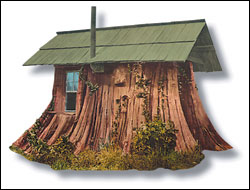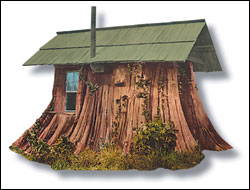SEATTLE’S OWN ARTS institutions are struggling, so it’s no surprise that the Eastsidewhere the arts topsoil is thinner is having problems, too. Last week, the Bellevue Art Museum (BAM) made the stunning announcement that it was closing its doors through at least the end of this year, only two and a half years after opening a $23 million, 36,000-square-foot Steven Holl-designed facility intended to be downtown Bellevue’s cultural anchor.
The museum, formerly housed inside Bellevue Square, never had much of a collection and shed what it did have in 1998. In cutting loose from the mall, it was grabbing for a bigger opportunity, to be a kind of Pacific Science Center of art, a place for people to “see, explore, and make art” though rotating exhibits, classes, and demonstrations. For the time being, though, it is essentially an empty box, a rather apt symbol of the dot-com boom that partly convinced the museum to venture out on its own.
IN THE BEGINNING, Bellevue’s place on the regional arts map grew out of the annual Pacific Northwest Arts & Crafts Fair. Hosted at Bellevue Square, the event’s commercial nature complemented the mall’s missionto sell stuffbut it also added a grassroots cultural element that was missing from life in so many culturally barren cul-de-sacs. The popular festival begat BAM, which took up residence in an old funeral home and later in the mall itself. For some, an art museum in a mall seemed weird, but it made sense given its roots, the patronage of the mall’s developer, Kemper Freeman Jr., and the fact that Bellevue Square is still the closest thing the city has to a town square.
As the years went by and Bellevue’s skyline grew, the folksy-crafty aspect of the fair and the museum seemed out of step with the higher ambitions of the city. LaMar Harrington, former head of the University of Washington’s Henry Gallery, who also directed BAM in the late ’80s, fueled those stirrings. She brought a new level of ambition, sophistication, and taste to BAM. A highly successful exhibition on architect Frank Lloyd Wright Bellevue’s modest equivalent of the famously successful King Tut exhibition at the Seattle Art Museumconvinced many that the museum had the potential to host major shows. As money and people flowed into the Eastside, BAM began to seriously explore its future. Many became convinced that, despite obvious risks, the museum ought to move out of Bellevue Square and into its own landmark facility. Once outside the box, it could grow and become a more visible player in the coming, more urbanized cultural life of the citya city that now boasted a large central park and increasing numbers of downtown high-rise residents. With dot-com dollars pouring in, it looked like the Eastside’s well-heeled patrons would support this amenity, which any real city had to have.
NOT AN UNREASONABLE assumption. Bellevue was at that point in its life cycle where such a risk made sense. Those who watch suburbs note their typical evolution is from bedroom communities to workplace edge cities and sometimes on to full-fledged cities. They note that arts ambitions are an early and key indicator of maturity. First come comfortable homes, then good schools, then retail conveniences, and shortly, a growing desire for all urban amenities, from coffee houses to performance stages. As traffic worsens, suburbanites start looking closer to home for entertainment. The last decade has seen performing-arts venues sprout on the Eastside, and in recent years, some multiplex movie theaters have even begun showing independent films.
But part of what’s happening in Bellevue can also be traced to that city’s attitude about growth, which has long been driven by a pretty conventional view of what makes a good city. Not unlike Seattle’s founders, who dubbed the city “New York Alki” (meaning, “New YorkEventually”), Bellevue has been operating in a kind of “Seattle Alki” mode. Bellevue wants what Seattle has, but without the inconvenience of clutter, diversity, and surprise. A pre-Sidranized town with skyscrapers, condo towers, freeway access, unfettered commerce. Today, its downtown is modestly more urban, yet still conveys a sterile, upper-middle-class monoculture whose civic agenda is driven by developers. In such places, the artseven mainstream artsseem alien.
IT DOESN’T HAVE to be that way. An alternative model is also in Bellevue, at Crossroads Shopping Center, a retail development that has taken as its model not downtown Seattle in the 1980s but a subset of that: the Pike Place Market. Set in a suburban neighborhood that features both a settled white middle class and a thriving multiethnic conglomeration of newcomers and immigrants, it has created a much more diverse, interesting retail environment that cultivates public space and the arts, particularly music with its popular concert series. Whatever comes to the Crossroads neighborhood in the future will likely grow out of an organic connection to the local community. Another example of success is the wonderfully appealing King County Library in downtown Bellevue, which is modern and, smartly, has the casual bustling ambience of a Barnes & Noble. Both are uniquely Bellevue, and neither is alien to art or creative energy.
So, it’s not that the Bellevue Art Museum can’t work, but they had things more right when it was still in the mall. That era’s over, however. Now BAM is going to have to become even more innovative if it is to revive itself. To do that, it must find a reason for being that is greater than serving as a trophy to the city’s ambitions.







